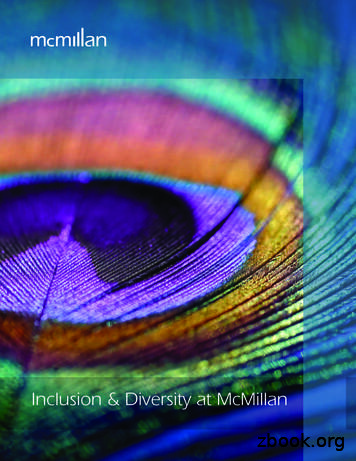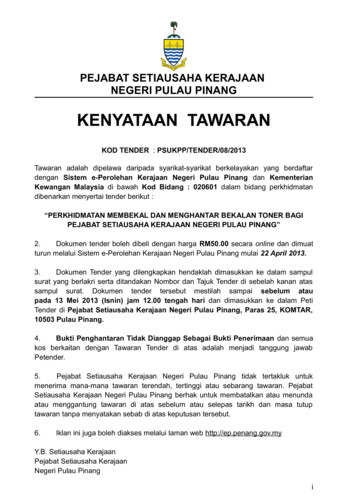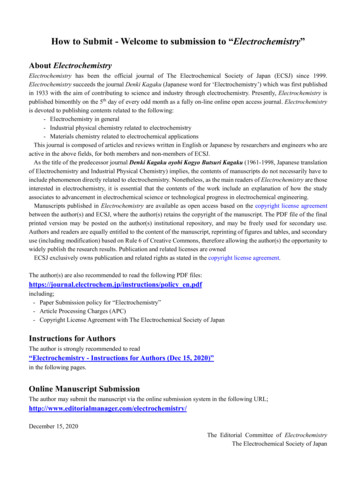Implementing Diversity & Inclusion Strategies In Higher Education .
Implementing Diversity & InclusionStrategies in Higher EducationInstitutions In Ireland and Its Impact onEmployee Perceptions.byPAUL IGBRUDEMSc in ManagementNATIONAL COLLEGE OF IRELAND“Submitted to the National College of Ireland, (August) (2021)”i
AbstractModern-day Irish society is becoming more culturally and ethnically diverse, thus leading to adiverse workforce. In ensuring equal opportunities in the labour market for all, the Irish governmentenacted the employment equality act 1998 -2011, which outlaws discrimination on nine groundseffectively making it illegal for organizations to discriminate against potential employees fromdifferent social-cultural backgrounds during the recruitment process and as employees within theorganization. (Bishop-Monroe, Wingender and Shimerda, 2020) in their research discussion withchief diversity officers from different organizations around the globe discuss the need fororganizations to develop strategies that enable them to monitor and measure diversity outcomes.Organizations can benefit from having an inclusive and diverse workforce by attracting a widespreadof talented candidates that can enhance a company’s competitive advantage. However, employeeperception of inclusion within the organization can impact positively or negatively on retention andthus creates the need for diversity and inclusion strategies to be continually assessed to ensure itseffectiveness. With the growth of third level education in Ireland in both staff and student numbersincluding international students, it is important that the higher education institutions in Irelandimplement diversity and inclusion strategies that positively impact staff and students alike.This dissertation delves into the implementation of diversity and inclusion strategies in HigherEducation Institutions in the Republic of Ireland and how these strategies are implemented and theimpact on employee perceptions.ii
DeclarationName: PAUL IGBRUDEStudent Number: X19174144Degree for which thesis is submitted: MSc MANAGEMENTMaterial submitted for award(a) I declare that the work has been composed by myself.(b) I declare that all verbatim extracts contained in the thesis have beendistinguishedby quotation marks and the sources of information specifically acknowledged.(c) My thesis will be included in electronic format in the College Institutional RepositoryTRAP (thesis reports and projects).(d) Either *I declare that no material contained in the thesis has been used in anyothersubmission for an academic award.Or *I declare that the following material contained in the thesis formed part of asubmission for the award of(State the award and the awarding body and list the material below)Signature of research student: Paul IgbrudeDate: 17/08/202143iii
AcknowledgementsFirstly I would like to thank almighty God for giving me the grace to complete this programme.I also want to thank my family for all your support and encouraging words, my colleagues at workincluding my line manager Noel O’Callaghan and Fionnuala Rahilly.My thanks and appreciation to my supervisor Dr Miguel Flores for your patience and guidance,your calm disposition and understanding towards me was very encouraging.This MSc programme has been one of the most difficult things I’ve had to do in my life and thedissertation was incredibly difficult but rewarding in the end and I would like to acknowledgeKeith Brittle and the NCI library team for the wonderful support given to me.Thank you to the HEIs and their employees who volunteered to be interviewed for this research itis very much appreciated.Finally I’d like to thank the NCI staff and lectures who supported me and my collegues in the lasttwo years directly and indirectly, I appreciate all your help.iv
Table of ContentsAbstract . iiDeclaration . iiiAcknowledgement .ivTable of Contents. vCHAPTER 1: INTRODUCTION . 11.1Introduction . 11.2The Purpose of the Study. 31.3Research Aims . 41.4Research Objectives . 41.5Diversity Correlation with Productivity . 51.6Diversity and Inclusion in the Republic of Ireland . 71.7Outcome of the Research . 91.8Structure and Organization of the Study . 10CHAPTER 2: LITERATURE REVIEW . 112.1Introduction . 112.2Diversity and Inclusion Conceptualization. 132.3The Approaches of Diversity Construct . 152.4Equal Opportunity Attribute Stage . 152.5Diversity Management Stage. 162.6Diversity & Inclusion Business Case . 182.6.1Ethnic, Gender, and Religion Diversities . 192.6.2Ethnic/Racial Diversity and Organization Performance . 192.7Diversity Management . 202.8Higher Education in the Republic of Ireland and Inclusion . 23CHAPTER 3 RESEARCH METHODOLOGY . 273.1Research Data and Method . 273.2Aims and objectives. 273.3Sample Population and Target Population . 28v
3.4Research Instrument . 303.4.1Semi-Structured Interview . 303.4.2Development of the Semi-Structured Questions . 303.4.3The Interviewing Process . 313.4.4Analysing the Interview data. 313.4.5Strengths and Weaknesses of the instrument . 313.4.6Strengths of the Instrument . 313.4.7Weaknesses of the Instrument . 323.5Data Analysis . 323.6Ethical Considerations . 333.7 The Higher Education Institution Anonymity . 333.7.1 The Anonymity of Participants Sensitive Information . 333.7.2 The University Ethical Measures . 34CHAPTER 4: PRESENTATION AND ANALYSIS OF DATA . 354.1Introduction . 354.2Objective 2:. 364.3Diversity and Inclusion Strategies of Higher Education Institutions in . 37the Repuclic of Ireland . 374.3.1Having Breakout Sessions and Training . 374.3.2Cultural Events . 384.3.3Periodic Employee Survey . 394.3.4Athena Swan Charter Membership . 394.3.5Content Creation and Distribution . 404.3.6Training the Trainer Outsourcing Program . 404.3.7Diversity Committee Meeting . 414.4Diversity and Inclusion Goals of Higher Education Institutions in the Republic of Ireland414.4.2Building a Cohesive Culture . 424.4.3Increase representation of the underrepresented groups . 434.5Objective 3:. 434.5.1Cohesive Behaviour in Organization . 444.5.2Increase in Retention and Reduction in Churn out Rate . 454.5.3Mental Health Wellbeing . 45vi
4.5.44.6Employee Positive Feedbacks . 46Objective 4:. 464.6.1Challenges in the Implementation of Diversity and Inclusion Strategies . 464.6.2Cultural Change for a lot of People . 474.6.3Hostility and Unsupportive Attitudes . 474.7Solutions to the Challenges of Implementing Diversity and Inclusion Strategies . 484.7.1 Having a Communication and Mentoring System . 484.7.2 Government should set Diversity and inclusion Objectives . 494.7.3 Hate Crime Legislation . 494.8Conclusion . 50CHAPTER 5: DISCUSSION . 515.1Introduction . 515.2Objective 1 Discussion . 525.3Objective 2 Discussion . 525.4Objective 3 Discussion . 535.5Objective 4 Discussion . 536.1Conclusions . 556.2Recommendations . 56REFERENCES . Error! Bookmark not defined.APPENDICES. 77Appendix 1 Research Information Leafle .77Appendix 2 Participant Consent Form 78Appendix 3 Interview Questions .79Appendix 4 Sample Code 80vii
CHAPTER 1: INTRODUCTION1.1IntroductionThe increasing growth and complexity of diversity and multiculturalism as a corporate andsocial phenomenon have generated interest in the social sectors such as health, media,workplace and education (Prasad et al., 2005). Diversity, which is now a common factor inthe workplace and international community, includes minorities, women, and age groups(Makhdoomi and Nika, 2017; Simons and Rowland, 2011). A reason that could be attributedthe international increase of, and complexity in diversity, is immigration. The movement ofpeople across borders has increased the cultural makeup of the population in countries; assuch, organisations are adopting diversity management strategies to optimize the competitiveadvantages and productivity gains inherent in diversity. (Mazur, 2010).SaintDic (2014) asserted that the pursuit of diversity and inclusion management could be dueto any of the following; financial, justice, equitability, and moral reasons.Research conducted over two decades that explored diversity management andimplementation in organisations found no legitimacy and financial gain for excluding womenand minorities from the workplace (Kolanaityte, 2010). Thus, suggesting the possible benefitsfrom diversity when it is properly managed. Companies in the United States of America andIT companies in India have started implementing diversity management strategies to becomemore competitive and attractive to a broader talent pool. (McMahon, 2010; Donnelly, 2015).Diversity is a concept that involves human differences, from a human resource perspective,managing and properly harnessing diversity strategies can attract and retain talent, and createa workplace that increases organisational performance. (Ashikali and Groeneveld, 2015).From a demographic perspective, diversity increases the intuitive resources of the team and1
thereby gives them the unequal ability to solve complex problems (Mason and Aramovich,2013).Organisational diversity suggests diversity in reasoning and critical thinking; when this isexplored and harmonised, it produces results unlikely to be found in mono teams. Accordingto Armstrong et al. (2010), diversity management integrates elements of the human resourcemanagement system and, firms that manage diversity demonstrate higher levels ofperformance. Similarly, Kossek et al. (2010), in their studies of human resource managementabout diversity management, posited that it is the relationship that exists between thedemographic representation of staff and human resources management policies, includingpractices such as development and promotions, which lead to desired outcomes for bothemployee and corporations. Therefore, human resource management is pivotal to theoptimisation of the gains in diversity management.Can diversity management impact job satisfaction, employee retention and organisationalperformance? Diversity in the workplace has been considered a strategic core value thatorganisations require to uphold the principles of equality and fairness (MorBarak, 2015; Ng& Sears, 2012).Administrative departments in organisations have been inspired to create apositive working environment, select skilled employees and develop processes and strategiesto deal with job-related issues (Mor Barak et al., 2016). Some scholars and studies haveasserted that workforce diversity management provides a system for solving employmentrelated matters such as equality, justice, inclusion, bullying; which are related to age, gender,ethnicity, the colour of the skin, etc. (Adams, 1965; Mor Barak, 2015; Thomas, 1990). Hence,for job satisfaction, the organisation should effectively manage its diversity issues in theworkplace.2
1.2The Purpose of the StudyFew studies explore diversity and inclusion in the Republic of Ireland particularly in HigherEducation Institutions (HEIs), and existing studies focus on social inclusion, religiousdiversity, and diversity among children (Magee et al., 2018; Connolly and Gallagher, 2016;Rougier and Honohan, 2014).In the study titled "19 Stories of Social Inclusion – Ireland: Stories of Belonging,Contributing and Connecting" the author employed a quantitative approach. They revealedthat for a socially inclusive goal for people with an intellectual disability, the following areneeded; the value of social inclusion, the enabler of social inclusion, and support for activitiesand qualities (Magee et al, 2018). In the research 'addressing diversity and inclusion in theearly years in conflict-affected societies', the research target was children. The studyconcluded that there is a need to form grassroots partnerships between various organisationson common ground (Connolly and Gallagher, 2016). The common ground is to promotediversity and inclusion strategies among children.However, Corrington et al (2020) conducted a study on the diversity and inclusion of anunderstudied group of employees in the United States. The understudied diversity variableswere religious minorities, transgender or gender non-conforming groups; political ideologies;undocumented immigrants, lower socioeconomic status; intersectional identities and thoseabove 65 years. They revealed different areas of study, but they asserted that diversity couldbe profitable and beneficial when appropriately harnessed. Diversity could cause or triggerbottom-line productivity, profitability, innovation, creativity, and other desirableorganisational outcomes (Roberson & Park, 2007).Therefore, the above research indicates the limited available research material in the study ofdiversity and inclusion in HEIsin Ireland and how it impacts its’ employee perceptions. Thegap this research seeks to fill is twofold; one, there is a lack of research to determine the3
effectiveness of diversity and inclusion within HEIs’sin the Republic of Ireland and theperceptions of the staff within these institutions. Secondly, a qualitative approach is needed tocollect data regarding the outcome of diversity and inclusion. Hence, this study shallinvestigate the impacts of diversity and inclusion strategies in HEIs and seek to understandits’ employees' perspectives on implementing of these strategies by adopting a qualitativeresearch methodology approach.Research methods is broadly grouped into quantitative and qualitative methods (Kothari,2004; Creswell, 1998; Kuzel, 1999). Quantitative research involves the measurement of anobject under study to determine specificity. In contrast, qualitative research consists ofstudying phenomenon or given variables based on the quality of those variables (Kothari,2004). For example, scientific experiments are usually quantitative research, whilebehavioural science studies are usually qualitative research.Kothari further explains that qualitative methodology is the method of data collection thatapplies to data that cannot be quantified. In contrast, the quantitative research method is adata collection method that uses an observation that can be quantified.1.3Research AimsThe research aims to investigate the implementation of diversity and inclusion strategies inHigher Education Institutions (HEIs’) in the Republic of Ireland and its impact employeeperceptions.1.4Research ObjectivesTo achieve the aims of this research, the following series of objectives shall provide clearguidance. To critically review existing literature on diversity and inclusion in Ireland and othercountries including the UK and the USA.4
To explore and critically analyse the strategies of diversity and inclusion currentlyimplemented in a HEIin the Republic of Ireland. To explore and critically examine employees' perceptions from a sample group ofHEIs’in the Republic of Ireland regarding the implementation of such diversity andinclusion strategies. To explore and critically analyse the challenges to the implementation of such diversityand inclusion strategies in the selected HEIs’. To make recommendations on what HEIs should do to harness the potential of diversityand inclusion in an organisation.1.5Diversity Correlation with ProductivityA McKinsey & Company report by (Vivian Hunt, et al., 2015) on diversity and inclusionrevealed that in a comparison of companies based on diversity, the most diverse organisationsare more likely to outperform their counterparts in terms of financial metrics (Dixon-Fyle etal., 2020).Reports on diversity and inclusion (2019,2017 and 2014) reiterated the above proposition thatthe top quartile for executive team gender equality would likely be more profitable thanorganisations in the fourth quartile (Hun et al., 2018; Dixon-Fyle, et al., 2020; Hunt, Laytonand Prince, 2015 ). The preceding suggests that executive gender diversity can impact thecompany's financial performance, which can be attributed to the diversity of strategies andsolutions to solve business problems arising in the team.However, does correlation connote causation? While the statistical data from the McKinseyreport signals a correlation trend between the level of diversity of an organisation and itsperformance, other factors also need to be taken into account. The report further revealed thatorganisations in the United States have a linear relationship between financial performance5
and diversity level. According to the report, for every 10 per cent increment of racial andethnic diversity in the senior executive team, financial return measured as earnings beforeinterest and taxes (EBIT) rises by 0.8 per cent (Hunt, Layton and Prince, 2015). Anotherfactor could be the capability to harness the potentials of a diverse team.Catalyst, an organisation whose vision is to increase the representation of women fromracially and ethnically marginalized groups in the corporate workplace, asserted thatcorporations with female boards had two financial return outcomes, 16 per cent higher returnon sales and 26 per cent return on investment (Carter and Wganer, 2011). Another Catalystreport found that for a company to optimise the potential of its female representatives at theboard level, instead of critical mass, three females are enough (Carter and Wagner, 2017).Despite the benefits gained from implementing diversity and inclusive strategies, someorganisations fail to harness the opportunities.A survey conducted by the Center for Talent Innovation (CTI) on black people in corporateorganisations found the following; 58% of black professionals are likely to admit they have experienced racial prejudiceat work relative to 15% of white professionals. 43 %t of black executives revealed they had experienced racially insensitive terms intheir presence by other races. 35 % of white women have professionals in their network who advocate for themcompared to 19% of black women professionals. 19% of black professionals always think that professionals in their race would neverattain top executive positions in the organisation, compared to 3% of whiteprofessionals who also have similar thoughts (Smith et al., 2019).According to Dobbins and Kalev ( 2016), some organisations have invested in pursuingdiversity and inclusion goals. However, the outcomes are still a matter of discussion,6
particularly as some organanisations diversity outcomes are mixed. In contrast, others haveyet to fully harvest the potentials of diversity and inclusion, which may imply a lack ofunderstanding of the importance of diversity and inclusion programs or they have failed torealise the adverse ripple effects of a non-inclusive culture on their brands.1.6Diversity and Inclusion in the Republic of IrelandWhile there is limited research in diversity and inclusion in the Republic of Ireland, theadvent of equality legislation has encouraged the education sector to promote diversity andinclusion within its Higher Education Institutions (HEIs’). As part of this research, one of theHEIs’ in the Rpublic of Ireland outlines its strategy for Equality, Diversity andInclusion(EDI) within the organisation as EDI pillars. In the 2018-2022 report, the strategicand action plan describes their EDI policy in Table 1.7
Table 1: The EDI PillarsHEI EDI PillarsRankAnalysisAge1stThe age excludes minors, as it starts from above 16years.Civil Status2ndThis group could include married, divorced,windowed, and civil partnered and single persons.Disability3rdThis group includes people with physical, mental,sensory, or intellectual impairments.Family Status4thThis group includes people such as pregnant women,parents, and caregivers of disabled adults.Gender5thThis group includes an individuals identity whichcould be male, female, non-binary, and transgender.Membership of the traveller6thcommunityRace/EthnicityA legally recognized minority ethnic group in thecountry.7thConnotes a person's colour, nationality, andethnicity.Religion8thIt consists of a person's religious beliefs, religiousbackground, and outlook.Sexual Orientation9thAn individual's sexual orientation, heterosexual,lesbian, gay, and bisexual.Socio-economic Status10thCharacteristics of a person's social and economicstatus or background.Source: EDI Strategic and Action Plan, 2018-2022The higher education institute's diversity and inclusion pillars are rooted in the Republic ofIreland legislation and constitution on diversity and inclusion. The employment equality Actof 1998-2015 outlaws areas relating to employment discrimination; which cuts acrossrecruitment and promotion, equal pay; working condition; training or experience; dismissal,and harassment, including sexual harassment (Citizens Information, 2021). The Acts furtherexplained that the legislation cut across nine areas of diversity which include; gender, civil8
status, family status, sexual orientation, religion, age, disability, race, and membership of thetraveller community.This EDI 2018-2022 strategic plan goes on to explain that the areas covered by theemployment equality act are; advertising, equal pay, access to employment, vocationaltraining and work experience, terms and conditions of employment, promotion or re-grading,classification of posts, dismissal, and collective agreements (EDI, 2018). The precedingsupports that the government is promoting diversity and inclusion with legislativeframeworks. Part 5 of the Disability Act of 2015 provides people with disabilities the right to3% employment representation in public service (National Disability Authority, 2015).Also, the code of practice on sexual harassment in 2012 was established to deepen thedevelopment and promotion of a workplace devoid of sexual harassment and where everyoneis respected (Code of Practice on Sexual Harassment and Harassment at Work, 2002). Thegovernment in the Republic of Ireland has laid a solid foundation for a workplace thatpromotes diversity and inclusion from the literature, legislation, and materials. This HEI hasconsolidated it by promoting policies towards realising diversity and inclusion strategies inthe Republic of Ireland.Therefore, this research investigates the impacts of diversity and inclusion strategies onemployee perceptions within the context of the HEI in Ireland.1.7 Outcome of the ResearchThe research question and objectives of the study were interrogated and answered in thisresearch paper which is shown in table 5. The key findings from the data involved engagingwith staff in breakout sessions and training, recognizing, and appreciating the differentcultural events, periodic surveys, collaborating with initiatives such as Athena Swan Charter,content creation and distribution, investing in training the trainer programmes and9
establishing equality diversity and inclusion committees. The forementioned will be useful indriving a purposeful diversity and inclusion strategies and impact positively on the diverseworkforce in the higher education institutions in Ireland.1.8 Structure and Organization of the StudyThe structure and organisation of this research is as follows; Chapter one introduction andbackground of the study with clarificationon the research question, aim andobjectivesCchapter two will discuss the literature review, Chapter three is methodology of theresearch, Chapter four presentation and analysis of the data, Chapter five discussion of thefindings and Chapter six is the conclusion of the study. As there is a dearth of literature forHEIs’, the next chapter shall critically review existing
implement diversity and inclusion strategies that positively impact staff and students alike. This dissertation delves into the implementation of diversity and inclusion strategies in Higher Education Institutions in the Republic of Ireland and how these strategies are implemented and the impact on employee perceptions.
PSI AP Physics 1 Name_ Multiple Choice 1. Two&sound&sources&S 1∧&S p;Hz&and250&Hz.&Whenwe& esult&is:& (A) great&&&&&(C)&The&same&&&&&
inclusion and diversity initiatives and events. Celebrating Inclusion and Diversity at McMillan Inclusion and Diversity Award In 2017, McMillan launched an Inclusion and Diversity Award which recognizes, on an annual basis, the contributions and efforts of a firm member who demonstrates a commitment to advancing diversity and inclusion at McMillan.
Argilla Almond&David Arrivederci&ragazzi Malle&L. Artemis&Fowl ColferD. Ascoltail&mio&cuore Pitzorno&B. ASSASSINATION Sgardoli&G. Auschwitzero&il&numero&220545 AveyD. di&mare Salgari&E. Avventurain&Egitto Pederiali&G. Avventure&di&storie AA.&VV. Baby&sitter&blues Murail&Marie]Aude Bambini&di&farina FineAnna
The program, which was designed to push sales of Goodyear Aquatred tires, was targeted at sales associates and managers at 900 company-owned stores and service centers, which were divided into two equal groups of nearly identical performance. For every 12 tires they sold, one group received cash rewards and the other received
College"Physics" Student"Solutions"Manual" Chapter"6" " 50" " 728 rev s 728 rpm 1 min 60 s 2 rad 1 rev 76.2 rad s 1 rev 2 rad , π ω π " 6.2 CENTRIPETAL ACCELERATION 18." Verify&that ntrifuge&is&about 0.50&km/s,∧&Earth&in&its& orbit is&about p;linear&speed&of&a .
AFMC Diversity, Equity, Inclusion and Accessibility (DEIA) Training 2 2 Diversity in BusinessDiversity in Business 3 Minutes 3 The Importance of Diversity The Importance of Diversity3 Minutes 4 The Power of Diversity 4 Minutes The Power of Diversity 5 The Threat of Diversity 2 Minutes The Threat of Diversity 6 Diverse Teams Deliver Results 1 Minute Diverse Teams Deliver Results
theJazz&Band”∧&answer& musical&questions.&Click&on&Band .
1000 days during pregnancy and the first 2 years of life, as called for in the 2008 Series. One of the main drivers of this new international commitment is the Scaling Up Nutrition (SUN) movement.18,19 National commitment in LMICs is growing, donor funding is rising, and civil society and the private sector are increasingly engaged. However, this progress has not yet translated into .























